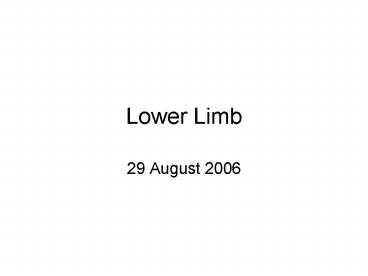Lower Limb - PowerPoint PPT Presentation
1 / 25
Title:
Lower Limb
Description:
Fibula overlapping posterior tibia. Axial sesamoids (Lewis method) Patient ... Distal tibia, fibula and talus seen. Tibiofibular articulation. Lateral ankle ... – PowerPoint PPT presentation
Number of Views:201
Avg rating:3.0/5.0
Title: Lower Limb
1
Lower Limb
- 29 August 2006
2
DP (AP) Toes
- Position
- Seated or supine on table
- CP 3rd metatarsophalangeal joint
- CR Perpendicular (non joint demonstration) nor
15 degrees to ankle if joint visualisation
required
3
Evaluation
- No rotation
- Open joint spaces on angled view
- Toes separate
- Distal end of metatarsals seen
- Soft tissue and trabecular seen
4
Oblique Toes
- Position
- As for DP
- CP 3rd metatarsophalangeal joint
- CR perpendicular
5
Evaluation
- All phalanges
- Oblique toes
- Open interphalangeal and 2-5th metatarsophalangeal
joint spaces - Toes separated
6
Lateral toes -positions vary according to which
toe
7
Evaluation
- Phalanges in profile
- No superimposition of phalanges
- Open joint spaces
8
DP Foot
- Position
- Patient supine
- Flex knee to place plantar surface on table
- CP base of 3rd metatarsal
- CR 10 degrees towards ankle (heel)
9
Evaluation
- No rotation
- Equal space between adjacent mid shafts of 2-4
metatarsals - Overlap of 2-5 metatarsal bases
- See phalanges, metatarsal and tarsals distal to
talus
10
Oblique Foot
- Position
- As for DP with leg rotated medially until plantar
surface forms angle of 30 degrees to IR - CP base of 3rd metatarsal
- CR perpendicular
11
Evaluation
- 3-5 metatarsal bases free of superimposition
- Lateral tarsals with less superimposition than DP
- Lateral tarsometatarsal and intertarsal joints
seen - Tuberosity of 5th metatarsal seen
12
(No Transcript)
13
Lateral foot (medio lateral)
- Position
- Lying on table turned to affected side with leg
and foot lateral - Opposite leg behind patient
- Support under knee
- Dorsi flex foot 90 degrees to lower leg
- CP base of 3rd metatarsal
- CR Perpendicular
14
Evaluation
- Metatarsals nearly superimposed
- Distal leg
- Fibula overlapping posterior tibia
15
Axial sesamoids (Lewis method)
- Patient prone
- Elevate ankle
- Great toe dorsiflexed
- Ball of foot perpendicular to horizontal plane
- CP 1st Metatarsophalangeal joint
- CR Perpendicular
16
Evaluation
- Sesamoids clear 1st metatarsal
- Metatarsal heads
17
Axial sesamoids (Holly method)
- ? More comfortable for patient
18
AP Ankle
- Supine with limb fully extended
- Place foot in true AP position
- Dorsi-flex ankle and foot to vertical
- CPmidway between malleoli
- CR perpendicular
19
Evaluation
- Tibiotalar joint
- Overlapping tibiofibular articulation with talus
(slightly overlapping distal fibula) - Both malleoli
20
AP mortise ankle
- As for AP but with medial rotation
- Both malleoli equidistant from IR
- CP between malleoli
- CR perpendicular
21
Evaluation
- Entire ankle mortise joint
22
Oblique ankle
- As for AP ankle but the entire lower leg is
medially rotated to a 45 degree position - CP midway between malleoli
- CR perpendicular
23
Evaluation
- Distal tibia, fibula and talus seen
- Tibiofibular articulation
24
Lateral ankle
- Supine patient turns to affected side until ankle
is lateral - Dorsi-flex foot
- CP medial malleolus
- CR perpendicular
25
Evaluation
- Fibula over posterior part of tibia































